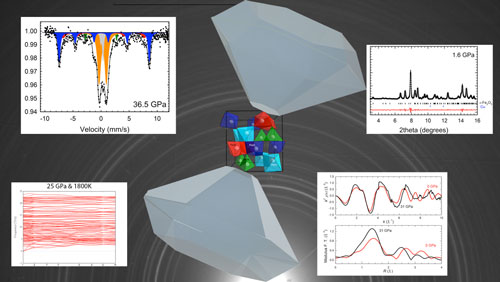| Dec 04, 2018 | |
New nanoparticle discovery paves the way for innovative magnetic devices(Nanowerk News) Researchers have characterised the structural, electronic and magnetic behaviour of nanoparticles of iron oxide in the epsilon phase under extreme pressure conditions. This process has led to the discovery of a new phase, epsilon prime, with magnetic properties that were unknown until now. |
|
| The difficulty to access the innermost parts of the Earth entails an absence of direct experimental studies on the minerals and compounds that control geodynamics and geomagnetism. Earth is mainly comprised of six elements: magnesium, aluminium, silicon and iron, in combination with hydrogen and oxygen. Therefore, all the studies on materials that include these elements in the appropriate conditions can open new lines of research that delve into the mysteries of the inside of our planet. | |
| Now, a team of researchers from the Universitat Politècnica de València (UPV), the Institut de Ciència de Materials de Barcelona (ICMAB-CSIC) and the European Synchrotron Radiation Facility (ESRF) has conducted a study, published in Nature Communications ("Stability and nature of the volume collapse of ε-Fe2O3 under extreme conditions"), which reveals that the epsilon phase (heretofore considered rare) can be found in the internal layers of the Earth. | |
 |
|
| Measurements and calculations conducted on ε-Fe2O3 nanoparticles. (Image: Asociación RUVID) (click on image to enlarge) | |
| In their work, the researchers characterised the structural, electronic and magnetic behaviour of nanoparticles of iron oxide in the epsilon phase under extreme pressure conditions. This process has led to the discovery of a new phase, epsilon prime, with magnetic properties that were unknown until now. | |
| “From the geophysical point of view, this finding is very relevant. It opens the door for this epsilon phase to possibly be found inside the Earth. On the other hand, a new phase of iron oxide has been discovered (under high pressures) which contains magnetic properties that differ from those that can currently be obtained. And having a material with these properties would mean the geodynamic models we know would have to be modified,” states Juan Ángel Sans, researcher with a Ramón y Cajal grant of the EXTREMAT group of the UPV’s Institute of Design and Fabrication (IDF). | |
| “We have been surprised by the epsilon phase to be stable at such high pressures, as much as 27 GPa, and that a new phase appeared when surpassing this pressure, the magnetic properties of which we still do now know very well,” explains Martí Gich, researcher of the ICMAB-CSIC. “This stability at high pressures indicates that it must be possible to incorporate other elements in high proportions to the epsilon phase with which to hopefully control its properties and capabilities,” he adds. | |
| The results of the study conducted by researchers from the UPV, ICMAB and ESRF make it possible to complete the vision of the behaviour of iron oxide and suggests that the presence of this material inside the Earth is possible. |
| Source: Asociación RUVID | |
|
Subscribe to a free copy of one of our daily Nanowerk Newsletter Email Digests with a compilation of all of the day's news. |
